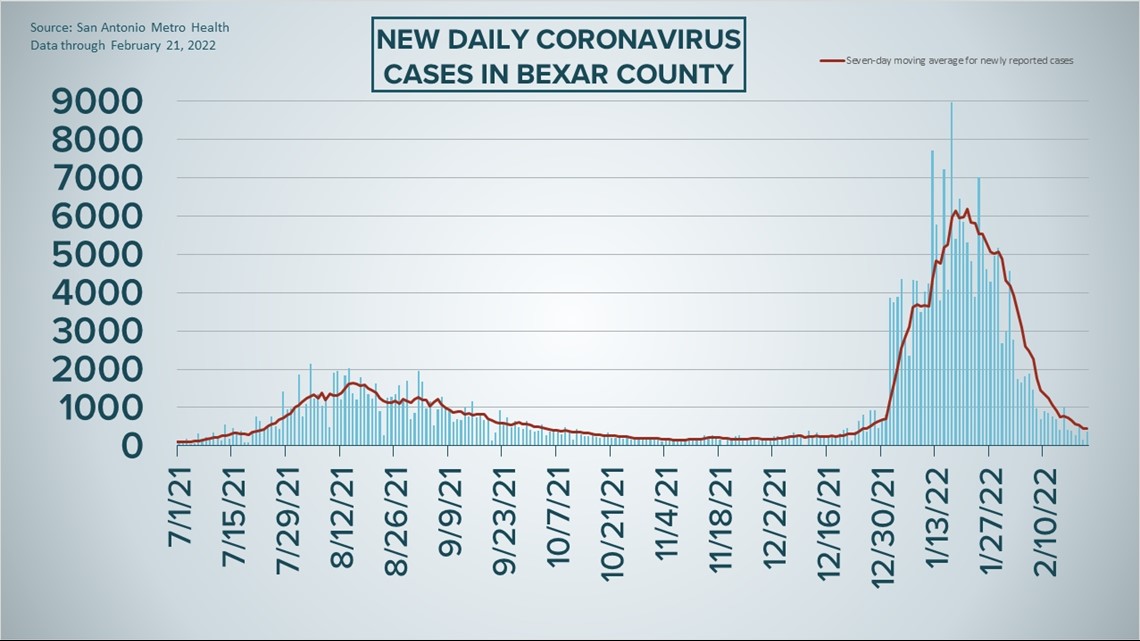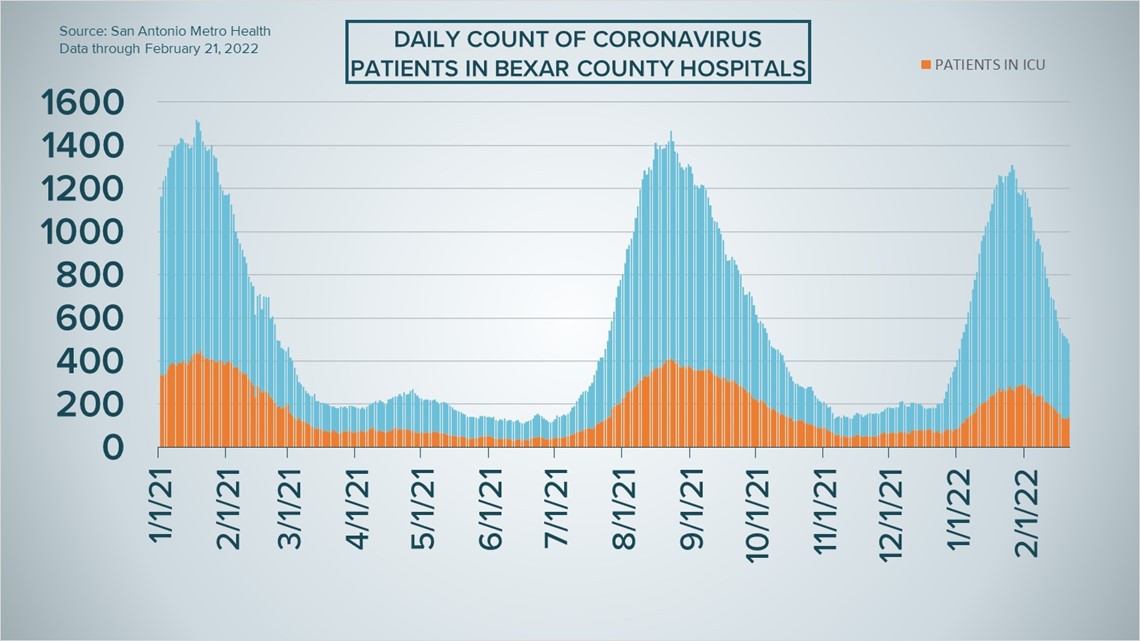SAN ANTONIO — COVID-19 hospitalizations continued to decrease in Bexar County over the weekend, and health authorities say 483 patients are receiving treatment in local hospitals as of Monday—the fewest since Jan. 2 as the community continues to recover from January's spike.
The number of county patients has gone down by 29% over the last week while decreasing by 59% since the start of February. Of those 483 patients, 140 are in intensive care and 74 are using ventilators.
Meanwhile, just once in the last week has Metro Health tallied at least 1,000 new infections as the omicron variant loosens its grip on the San Antonio area. That includes 365 additional cases reported Monday, bringing the region's seven-day case average down to 452, a new low for 2022.
February has averaged 1,163 new infections a day, a far more manageable figure than the nearly 4,200 daily cases which were being reported in January. Just 685 infections were reported over the weekend, including a new 2022 low of 151 infections on Sunday.
Nearly 521,000 county residents have been diagnosed with the virus over the last two-plus years.
Four more virus-related deaths were reported Monday, bringing the local death toll to 5,231.
How Bexar County is trending




Vaccine Progress in Bexar County
The following numbers are provided by San Antonio Metro Health. A full breakdown can be found here.
- 1.743 million eligible Bexar County residents have received at least one dose of the coronavirus vaccine as of Thursday, Feb. 17.
- 1.42 million eligible Bexar County residents are fully vaccinated as of Thursday, Feb. 17.
The CDC states that "when a high percentage of the community is immune to a disease (through vaccination and/or prior illness)," that community will have reached herd immunity, "making the spread of this disease from person to person unlikely."
The City of San Antonio breaks down the vaccination rates by zip code on Metro Health's Vaccination Statistics page.
Coronavirus in Texas
The total number of coronavirus cases in the state since the pandemic began grew by 5,018 on Monday, according to the Texas Department of State Health Services. That total includes 3,439 new confirmed cases and 1,579 new probable cases. More details can be found on this page.
Monday's figures bring the total number of Texans diagnosed with COVID-19 to more than 6.517 million.
An additional 19 Texans have died from virus complications, meanwhile, raising the statewide death toll to 82,435.
Coronavirus symptoms
The symptoms of coronavirus can be similar to the flu or a bad cold. Symptoms include fever or chills, cough, shortness of breath or difficulty breathing, fatigue, muscle or body aches, headache, new loss of taste or smell sore throat, congestion or runny nose, nausea or vomiting, and diarrhea, according to the Centers for Disease Control.
Most healthy people will have mild symptoms. A study of more than 72,000 patients by the Centers for Disease Control in China showed 80 percent of the cases there were mild.
But infections can cause pneumonia, severe acute respiratory syndrome, kidney failure, and even death, according to the World Health Organization. Older people with underlying health conditions are most at risk.
Experts determined there was consistent evidence these conditions increase a person's risk, regardless of age:
- Chronic kidney disease
- COPD (chronic obstructive pulmonary disease)
- Obesity (BMI of 30 or higher)
- Immunocompromised state (weakened immune system) from solid organ transplant
- Serious heart conditions, such as heart failure, coronary artery disease, or cardiomyopathies
- Sickle cell disease
- Type 2 diabetes
- The CDC believes symptoms may appear anywhere from two to 14 days after being exposed.
Human coronaviruses are usually spread...
- Between people who are in close contact with one another (within about 6 feet).
- Through respiratory droplets produced when an infected person coughs, sneezes or talks. These droplets can land in the mouths or noses of people who are nearby or possibly be inhaled into the lungs.
- Some recent studies have suggested that COVID-19 may be spread by people who are not showing symptoms.
Help stop the spread of coronavirus
- Stay home when you are sick.
- Eat and sleep separately from your family members
- Use different utensils and dishes
- Cover your cough or sneeze with your arm, not your hand.
- If you use a tissue, throw it in the trash.
Find a Testing Location
City officials recommend getting a COVID-19 test if you experience fever or chills, cough, shortness of breath or difficulty breathing, fatigue, muscle or body aches, headache, new loss of taste or smell, sore throat, congestion or runny nose, nausea or vomiting, or diarrhea.
Here's a Testing Sites Locator to help you find the testing location closest to you in San Antonio.
Latest Coronavirus Headlines
- No, hospitals don’t get more money when they list COVID-19 as a patient’s cause of death
- Texas sues CDC to stop mask mandates on planes
- Verify: Yes, the coronavirus pandemic will eventually become an endemic
- Fox News anchor back on air after he was in ICU with COVID
- Carnival Cruise Lines to drop mask mandate for passengers
- Queen Elizabeth II tests positive for COVID-19
- Yes, unauthorized immigrants in the U.S. can request free COVID-19 tests from the government
- Getting COVID-19 vaccine toward end of pregnancy gives a bigger boost of antibodies to babies, doctor says

